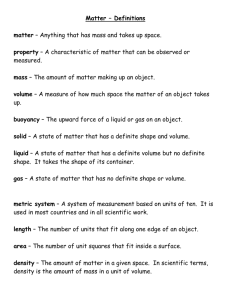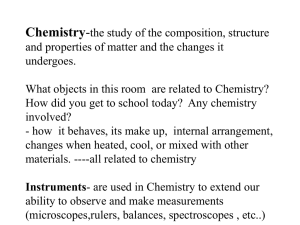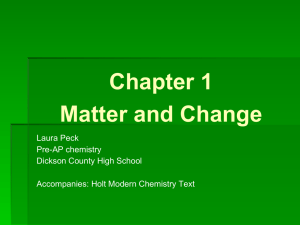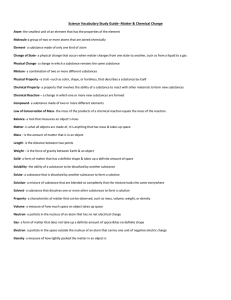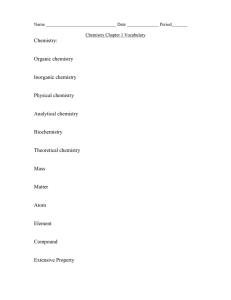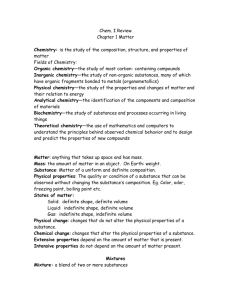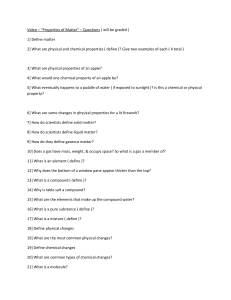Chapter 1 Notes
advertisement
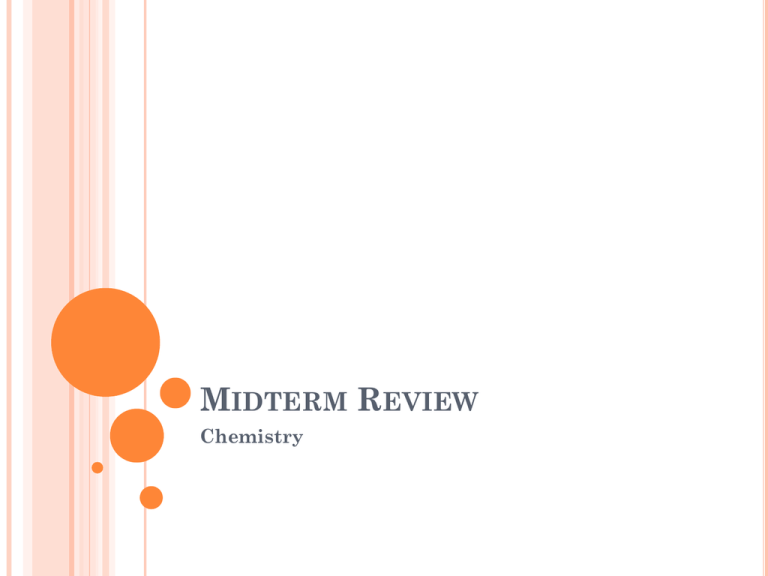
MIDTERM REVIEW Chemistry CHAPTER 1 THE SCIENCE OF CHEMISTRY PG 4-9 Chemistry – the study of matter and how it interacts with other matter Chemical – any substance that has a definite composition. A chemical is always made of the same “stuff” no matter where it comes from EXAMPLES OF CHEMICALS CHEMICALS Not all chemicals are bad. Chemicals are necessary for every day life. STATES OF MATTER Three states of matter: Solid Liquid Gas SOLIDS Have a fixed volume and definite shape. Atoms are held tightly in rigid structure and vibrate only slightly LIQUIDS Have a fixed volume and indefinite shape Can easily take the shape if its container GASES Indefinite volume and indefinite shape Atoms are held very loosely together PRODUCTS VS REACTANTS Products are what come out of a reaction Reactants are what are put into the reaction REACTANTS: H2 AND N2 PRODUCT: NH3 DESCRIBING MATTER SECTION 2 PG 10 -19 Matter - anything that has mass and volume List of non-matter: Time Sound Sunlight Thoughts Gravity Microwaves Heat Memories Reflections Energy VOLUME VS MASS Volume – is the amount of space an object takes up Mass – the amount of matter in an object https://www.youtube.com/watch?v=kWpgyn OgkVE VOLUME VS MASS Volume is measured in liters, gallons, or some unit cubed (cm3, m3, in3) Mass is measured in grams MEASURING VOLUME Fill a graduated cylinder and read the lines. The lines measure mL Just like the lines on a ruler measure cm WHAT IS THE VOLUME OF THIS LIQUID? WHAT IS THE MASS OF THIS LIQUID? DETERMINING MASS Mass is measured in grams. To find the mass of something, you must you a scale or balance. MASS VS WEIGHT Weight is the force produced by gravity acting on a mass. The mass of an object never changes. Weight varies depending on gravity. DENSITY Density – is the ratio of mass to volume of an object. How much “stuff” is in an object compared to how much space it takes up. Density = Mass/Volume DENSITY Density can be used to identify substances Every pure element has a specific density that does not change SECTION 3 HOW IS MATTER CLASSIFIED? PG 21 -28 Atoms – the smallest unit of an element that maintains the properties of that element PURE SUBSTANCE Pure substances are either elements or compounds. Pure substances have definite chemical and physical properties ELEMENTS Are substances that cannot be broken down into anything else. Composed of only one type of atom COMPOUNDS Composed of more than one type of atom. Still have definite properties. Examples : H2O CO2 C12H6O12 MIXTURES Do not have definite compositions or definite properties Examples: Salt Water Sand Sugar Water HETEROGENEOUS VS HOMOGENEOUS Homogeneous – mixture is distributed uniformly throughout Heterogeneous – mixture is not distributed uniformly throughout
